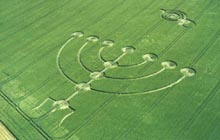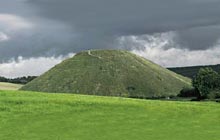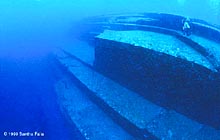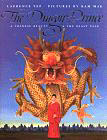|
|


Editorial
|
Fragments
|
Shasta II
|
Sea Serpents II
|
Atlantis II
Register
for our new Hall of Records Newsletter!
Questions? Comments? Suggestions? Advertising? Press Releases?
Contact us!
Crop Circles
|
Silbury Hill
|
Chinese Sea Serpent
|
Yonaguni
|
Books
|
Video


This menorah appeared in the fields of
southern England,
in
Wiltshire,
near Barbury Castle in 1999. Almost certainly man-made, this menorah is relatively simple compared to some of the
incredibly complex patterns,
many of which appear to be beyond the ability of man to create.
Image copyright © 1999
Steve Alexander.
|
|
The mystery of the "crop circles" is
an old enigma
that has exploded in recent times. Highly contoversial and
frequently debunked,
crop circles
are circular areas of flattened wheat, corn, and various types of crops and grasses that have been found in many places
all around the world, but are found most frequently by far in
southern England,
in the same mysterious area that contains Silbury Hill (q.v.),
Stonehenge,
Avebury, and
numerous other sites
of historical and archaeological interest.
The oldest known recorded crop circle event occurred in the 9th century in France, where the Bishop of Lyon sent out a prohibition
to the recently converted locals against using seeds taken from crop circles for pagan fertility rituals.
Another historical crop circle event occurred in Hertfordshire, England in August 1678. The information comes down to us via an
old pamphlet telling the story of a
"Mowing Devil".
The pamphlet
tells the story of a farmer who, bargaining with a mower to mow his field, became so angry at the price the mower was
asking that he swore that "the Devil should mow it rather than he". That night, a bright light appeared over the farmer's
crops, and in the morning, the farmer found that his crop had been neatly cut, "so neatly mow'd by the Devil or some
Infernal Spirit, that no Mortal Man was able to do the like."
In the 1970s crop circles began to appear again in force, at first forming relatively simple circular patterns that are easy
for man to duplicate. The 1980s and 90s, however, saw progressively more and more complex designs that grew more and more
difficult to explain away as the acts of pranksters. The years
1997,
1998,
1999
saw an explosive growth in the quantity and intricacy of crop circles, and
2000, 2001 and
2002
proved to be particularly interesting, with extremely intricate crop circles and even one crop circle
"face".
Though many if not most crop circles can be explained away as the work of pranksters, some crop circles display attributes that
cannot be explained by the simple "board and string" technique used by some. These include, among others, evidence of rapid
heating, brittle stalks that are bent, and not broken, as are those found in circles devised by pranksters, and interweaving of
and swirling of stalks to such a degree that mechanical procedures are not able to replicate them.
There are many
theories
on how and why crop circles are formed, ranging from "plasma vortexes" to extraterrestrial communications. Most recently,
Colin Andrews,
Britain's leading researcher on the subject of crop circles, has come out with the
theory
that as many of 80% of all crop circles are manmade, and the remaining 20% are created not by aliens, but by shifts in Earth's
magnetic fields. These 20%, he believes, are the simpler circles, not the complex ones, as one might assume.
Other factors that make the Silbury Hill area such a prime candidate for geomagnetic effects include the predominance of
subsurface water in the area, and a convergence of what are called
"ley lines", natural lines of geomagnetic force
believed by some mystics to be a "vital current" which flows through various parts of Earth. In the case of the Silbury Hill
area, some theorize, the large amount of water running through underground chalk deposits may cause electrical charges to
build up, which manifest themselves in the form of "fairy lights" that are often seen around crop circle formations. These
will o' the wisps
then discharge themselves into the ground in a swirling pattern, creating the swirling "crop circle" effect as the opposing
electrical charges between sky and ground neutralize each other radially.
Though crop circles can be found in most parts of the world, by far the majority of crop circles appear in the County of
Wiltshire
in
southern England
during the summer. The Wiltshire area is rich in history and legend, so there is
plenty to do
while waiting for the next crop circle, and they have been coming fast and furious, particularly with the release of the movie
Signs.
Be sure to visit the
Silent Circle Cafe
open during crop circle season, starting June 1.



 The International Crop Circle Database
The International Crop Circle Database
 Crop Circle Expert Colin Andrews' Site
Crop Circle Expert Colin Andrews' Site
 Fortean Times: The "Mowing Devil"
Fortean Times: The "Mowing Devil"
 Swirled News: The Silent Circle Cafe
Swirled News: The Silent Circle Cafe
 Mysterious Britain: Will o' the Wisp
Mysterious Britain: Will o' the Wisp
 Colin Andrews: Crop Circle Info
Colin Andrews: Crop Circle Info
 Paranormal News: Crop Circles
Paranormal News: Crop Circles
 Lucy Pringle's Crop Circle Site
Lucy Pringle's Crop Circle Site
 www.cropcircleresearch.com
www.cropcircleresearch.com
 BBC News: Crop Circles
BBC News: Crop Circles
 Crop Circle Connector
Crop Circle Connector
 The Silent Circle Cafe
The Silent Circle Cafe
 Art Bell: Crop Circles
Art Bell: Crop Circles
 The Wiltshire Web
The Wiltshire Web
 Crop Circle Central
Crop Circle Central
 The Crop Circular
The Crop Circular
 Crop Circle Quest
Crop Circle Quest
 Swirled News
Swirled News
 Circlemakers
Circlemakers
 Signs
Signs
|
|
|


Silbury Hill, located at the
epicenter
of the crop circle (q.v.) phenomenon in
Wiltshire,
in
southern England.
Silbury Hill is believed by some to be the centerpiece of a series of ancient religious structures to be found in
southern England, including, among others,
Stonehenge
and
Avebury.
Image copyright © 2001
Current Archaeology.
|
|
Silbury Hill is a massive, ancient earth mound that sits at the heart of a
sprawling religious metropolis
that had
dominated southern England for thousands of years before the coming of Christianity. At 130 feet, it is the tallest
man-made mound in Europe. Silbury Hill dwarfs Wisconsin's
Aztalan
primary mound, and even rivals Illinois'
Cahokia
primary mound in size. However, unlike the squared Aztalan and Cahokia primary mounds, Silbury Hill is
perfectly round.
Silbury Hill was built on top of a large chalk outcropping from chalk bricks covered with layers of earth to prevent its
rapid dissolution from wind and weather. It was
built in stages,
the first stage built around 2500 b.c. of chalk brick covered with chalk rubble. Various other phases added additional layers
of chalk rubble and earth, finally being covered with Earth and grass which proved to be an effective protection against the
elements, but not from humans.
Silbury Hill's exact purpose is still unknown.
One writer
by the name of Moses B.Cotworth, writing at the beginning of the
20th century, stated that "Silbury [is] a giant sundial to determine seasons and the true length of the year." Others believe
that it is a burial mound for a great ancient king name Sil whom,
legends tell,
was buried in golden armor, sitting on a golden horse.
Perhaps like
Cahokia's
main mound, it was used primarily as a ceremonial center from which, it was believed, the deities of heaven and earth could
be reconciled and the natural order kept in balance. Some believe Cahokia also was used as part of a solar calendrical system,
lending weight to Cotworth's "giant sundial" theory.
The prevalence of other calendrical structures in the region (Avebury, Stonehenge) would tend to point towards the latter
conclusion, but there is also evidence that the mound was used for burial purposes. According to
William Stukeley,
the
first excavation
of the mound took place in 1723, which uncovered some bones, and an ancient horse's bridle, perhaps the basis of the legend of
the golden horse and rider buried within the mound. The fact that no intact skeletons were found, only some bones and a bridle,
may indicate that the mound had been plundered long ago for its legendary gold, but one can only speculate. A
second excavation
took place in 1776 under the auspices of the Duke of Northumberland, who used miners to sink a hole straight down deep into
the hill, apparently to look for the fabled treasure. Other holes were dug from the side of the mound in 1849 and 1967 with
no success. In May 2000, the hole dug by the Duke of Northumberland
reopened,
as the Duke's cap of the hole gave way, exposing the Duke's excavation. The hole was covered and fenced
off, but some misguided
crop circle researchers allegedly broke into the mound and
unintentionally caused
a great deal of damage
in the process. Here are some of their
images of the interior.
The controversial crop circle phenomenon (q.v.) appears to be centered around the Silbury Hill area. Many crop circle
researchers ("Cerealogists"), and related researchers believe that Silbury Hill lies at the convergence of multiple
ley lines, lines of geomagnetic force that
lie at the heart of the practice of
geomancy
known in the East as feng shui. Practitioners of feng shui (lit. "wind and water") and geomancy believe that
powerful currents of magnetic force run through the landscape over the entire surface of Earth. Through proper alignment with
these natural currents of magnetic force, they believe they are able to harness these energies for their
own use. Further scientific study in this area may not only solve the mystery of the crop circle phenomenon, but also the meaning
of Silbury Hill.
To avoid additional intrusions and erosions due to excessive traffic on its slopes, unfortunately, Silbury Hill is closed to the
public. The area around the mound is accessible, however, and parking is available.
Silbury Hill is located
on the A4 between West Kennet and Beckhampton, Wiltshire, and can be viewed any time of the year.



 Visit Wiltshire: Official Tourism Website
Visit Wiltshire: Official Tourism Website
 English Heritage: Silbury Hill
English Heritage: Silbury Hill
 Mysterious Wiltshire: Silbury Hill
Mysterious Wiltshire: Silbury Hill
 Earth Mysteries: Silbury Hill
Earth Mysteries: Silbury Hill
 Current Archaeology: Silbury Hill
Current Archaeology: Silbury Hill
 The Heritage Trail: Silbury Hill
The Heritage Trail: Silbury Hill
 stonehenge.co.uk: Silbury Hill
stonehenge.co.uk: Silbury Hill
 Welcome to Southern England
Welcome to Southern England
 Multimap.com: Silsbury Hill
Multimap.com: Silsbury Hill
 Britain Express: Silbury Hill
Britain Express: Silbury Hill
 www.henge.org.uk: Silbury Hill
www.henge.org.uk: Silbury Hill
 Megalithic Mysteries: Silbury Hill
Megalithic Mysteries: Silbury Hill
 Stones of England: Silbury Hill
Stones of England: Silbury Hill
 Go Brittania! Earth Mysteries: Silbury Hill
Go Brittania! Earth Mysteries: Silbury Hill
 BBC News: "Scanners Probe Stone Age Mystery"
BBC News: "Scanners Probe Stone Age Mystery"
 Only In Britain
Only In Britain
 Lonely Planet: England
Lonely Planet: England
 All Travel England
All Travel England
 TravelEngland.org.uk
TravelEngland.org.uk
|
|

|


Sea serpents and dragons are popular elements in the folklore of China and throughout the Far East. There are various
different types of dragons in Chinese folklore, each of which has control over various natural phenomena. Image from
The Circle of the Dragon.
|
|
A mysterious, serpentlike creature has recently been spotted in the
Tianchi Lake,
a deep, volcanic lake in the north-eastern
Jilin province
in China, near the China/Korea border. The creature, which appears as a
long, black serpentine creature
with a horselike head, has been seen
leaping out of the water
as close as 30 feet from the shoreline. Hundreds of people claim to have seen the mysterious
creature, but no photographs have surfaced as yet.
Rumours of a serpentlike creature in Tianchi Lake have been circulating for close to a century. However, scientists are
skeptical of the possibility, largely because there has been
volcanic activity
in the lake as early as 300 years ago, which
would have made life extremely hazardous for anything living in the lake. Despite this, local fans of the creature have
organized the "Tianchi Monster Society" in hopes of finding the creature.
There are
two different types
of dragons in
Chinese mythology:
the Kiao, and the Shan. The Kiao are a cross between a dragon and a serpent.
They have a smaller head, a thinner, more sinuous body and live within lakes and rivers. The second kind, the Shan,
are like the Kiao, but they have ears, horns, and a red mane, and live in the sea. Chinese dragons are considered to be
the most powerful of all creatures, but are generally benificent to man. Most Kiao are believed to live in opulent
palaces at the bottom of lakes and rivers. Both types of dragons were believed to control the weather, and were able to fly
without the aid of wings with the help of a special organ on their head called the chi'ih-muh. Male dragons are
distinguished from females by the fact that their horns are slightly undulating, and thicker at the top, whereas the female
is distinguished by a rounded mane, straight nose, thinner scales, and a very strong tail."
Jilin province
is located in the northeast region of China, on the border with North Korea. During World War II it served as the "puppet
Manchukuo State" that the Japanese used to administer the conquered regions of China. Other interesting points of interest
besides
Tianchi Lake
and its monster include the Manchukuo Imperial Palace, Jingyue (Clear Moon) Pool, the Changchun Film
Studio, the waterfront city of Jilin, the rimed trees of Jilin, Songhua Lake, and many more beautiful natural and manmade
attractions. For more information on visiting China, check out the
China National Tourism Administration Travel Tips
page, or check out the links below.



 Travel China Guide: Tianchi Lake
Travel China Guide: Tianchi Lake
 China National Tourism Association
China National Tourism Association
 Travel China Guide
Travel China Guide
 China Travel Service
China Travel Service
 BeijingTrip.com
BeijingTrip.com
 Imperial Tours
Imperial Tours
 CNN.com: "Chinese Nessie 'Alive and Well'"
CNN.com: "Chinese Nessie 'Alive and Well'"
 ABC News Online: "China lays claim to its own Nessie"
ABC News Online: "China lays claim to its own Nessie"
 Independent Online: "Chinese 'Nessie' Emerges from Volcanic Lake"
Independent Online: "Chinese 'Nessie' Emerges from Volcanic Lake"
 Far Eastern Sea Serpents
Far Eastern Sea Serpents
 The Circle of the Dragon: Eastern Dragons
The Circle of the Dragon: Eastern Dragons
 The Circle of the Dragon: Famous Dragons - China
The Circle of the Dragon: Famous Dragons - China
 Illiana the Golden Dragon: Chinese Dragons
Illiana the Golden Dragon: Chinese Dragons
 Pantheon.org: Shachihoko
Pantheon.org: Shachihoko
 Sea Serpents Origami
Sea Serpents Origami
|
|
|


The "Yonaguni Monument" southwest of Okinawa, Japan. "Yonaguni", as it is typically called,
takes its name from the small nearby island of
Yonaguni,
the westernmost of the
Ryukyu archipelago
of islands that stretches from Kyushu to Taiwan.
Image
© 1999 Santha Faiia.
|
|
In July of 1986, Kihachiro Aratake, a diveshop owner on
Yonaguni Island,
a small Japanese island
southwest of Okinawa,
strayed outside of the safety perimeter to dive the unknown areas west of the island. What he found was nothing
short of astonishing, something that has baffled geologists, archaeologists, and historians alike ever since.
Not far outside the perimeter, only 200 feet off of a set of sheer cliffs called
Iseki Point,
he stumbled across a low, rambling, monolithic structure that appeared, at least at first glance, to be a large,
manmade temple complex or similar structure.
The
structure itself
is roughly 240 feet long, 90 feet wide and is apparently only one of a complex of structures that dot the sea bed for
hundreds of miles.
Masaaki Kimura,
a professor at University of the Ryukyus, Department of Science Faculty, has dated it as being anywhere from 6,000 to
10,000 years old, based upon fossil remains found on the monument. Since Earth's oceans have risen
over 120 feet in the past 10,000 years, from 6,000-10,000 years ago the Monument would have been well above water.
Most historians, archaeologists and geologists, including
Robert Schoch
— who is known for his
redating of the Sphinx —
have dismissed the "Monument" as purely natural. Schoch believes that the
sharp right angles to be found throughout the
site are part of the natural process of erosion, where the soft stone of which the "Monument" is
composed tends to flake off along parallel lines, over time creating the angular features of the Monument.
Kimura and others disagree, however, pointing out that
numerous features
around the monument, including what appear to be
"post holes", clearly defined stairways, and the structure's similarity to other aboveground structures on the island of
Yonaguni, make it unlikely that the structure was purely natural. In the end, both Schoch and Kimura come to the conclusion
that the structure was most likely "terraformed", where the builders worked around the Monument's natural features to adjust
it to suit their needs.
Yonaguni Island offers excellent, year-round diving opportunities, both for the monument and for the sealife. Note: Only
licensed divers with experienced guides should attempt to search for the Monument. For more information on visiting Yonaguni,
please consult the following links:



 Atlantis Rising: Japan's Underwater Ruins
Atlantis Rising: Japan's Underwater Ruins
 Okinawa Summit 2000: The True Value of the Undersea Ruins
Okinawa Summit 2000: The True Value of the Undersea Ruins
 Okinawa Summit 2000: Map of Okinawa
Okinawa Summit 2000: Map of Okinawa
 The Morien Institute: Yonaguni
The Morien Institute: Yonaguni
 Cybermike: Yonaguni
Cybermike: Yonaguni
 Temple of Mu
Temple of Mu
 Laura Lee: Yonaguni
Laura Lee: Yonaguni
 GrahamHancock.com: Yonaguni
GrahamHancock.com: Yonaguni
 DiverNet: Lost World of Okinawa
DiverNet: Lost World of Okinawa
 Asian Diver: The Sunken City at Yonaguni
Asian Diver: The Sunken City at Yonaguni
 The Okinawa Scuba Connection
The Okinawa Scuba Connection
 Xpeditions Magazine: Yonaguni
Xpeditions Magazine: Yonaguni
 Fathoms Diving Okinawa
Fathoms Diving Okinawa
 Dive Japan: Okinawa
Dive Japan: Okinawa
 Torii Training: Okinawan Dive Instruction
Torii Training: Okinawan Dive Instruction
 Team Atlantis: Yonaguni
Team Atlantis: Yonaguni
 Silent Network: Yonaguni
Silent Network: Yonaguni
|
|
Crop Circles
|
Silbury Hill
|
Chinese Sea Serpent
|
Yonaguni
|
Books
|
Video
Editorial
|
Fragments
|
Shasta II
|
Sea Serpents II
|
Atlantis II
Register
for our new Hall of Records Newsletter!
Questions? Comments? Suggestions? Advertising? Press Releases?
Contact us!



 The Deepening Complexity of Crop Circles: Scientific Research and Urban Legends
The Deepening Complexity of Crop Circles: Scientific Research and Urban Legends
Eltjo H. Haselhoff
Eltjo Haselhoff has written the first book on crop circles based on scientific evidence. His research, as intoduced in the first chapter, "A Great But Most Tangible Mystery," addresses some of the most concrete crop-circle phenomena: the dead fly enigma, curious deposits, germination anomalies, and balls of light. Studies with mathematical formulas allow any reader to analyze and verify, or dispute, the author�s findings. For those interested in a more metaphysical approach, the author provides "The Psychic Perspective: Earth Forces, Aliens, Gate to Another World, and Messages from the Cosmos." Diagrams and color photographs throughout the book guarantee a fascinating journey through the world of crop circles even for those not inclined toward laboratories and numbers.
(Review by Amazon.com)
Click
here
to buy this book.
 Opening Minds: A Journey of Extraordinary Encounters, Crop Circles, and Resonance
Opening Minds: A Journey of Extraordinary Encounters, Crop Circles, and Resonance
Simeon Hein, Ira Liss (Illustrator)
Opening Minds is about a social scientist's voyage into the world of non-ordinary, multidimensional energy phenomena. The book is both an examination of the limited belief systems intrinsic to existing mechanistic worldviews and an exploration of emerging new paradigms based on subtle-energy sciences. New discoveries in physics, combined with a greater awareness of extraordinary phenomena that surround us, challenge our traditional beliefs in the mechanistic universe of Sir Isaac Newton. Research into remote viewing, crop circles, and extraterrestrials shows our world to be vibrant, multidimensional, and mysterious. The author shows us how we can connect with this infinite universe. Read how many crop circles are made from first-hand accounts!
(Review by Amazon.com)
Click
here
to buy this book.
 The Secrets of the Avebury Stones: Britain's Greatest Megalithic Temple
The Secrets of the Avebury Stones: Britain's Greatest Megalithic Temple
Terence Meaden
Avebury, less than 20 miles from its more famous neighbor, Stonehenge, is rich in symbols linked to pre-Christian
Goddess religions. This book reveals the wonders of the site, the largest and most complex prehistoric monument
in Britain, through a lavishly illustrated guided tour encompassing history, archaeology, spirituality, and art.
(Review by Amazon.com)
Click
here
to buy this book.
 The Book of Sea Monsters
The Book of Sea Monsters
Bob Eggleston and Nigel Suckling
Rating:    
For millennia, humankind has been fascinated by the awesome power of the sea and the creatures sheltered by its depths.
In the past, ocean crossings toward new horizons were not just challenges of the physical elements, but defiances of the perils
which the human imagination projects onto the unknown. Now, in The Book of Sea Monsters, these mythical creatures of the
deep are vividly brought to life by award-winning artist Bob Eggleton. Exploring the myth, legend, scientific documentation and
fiction inspired by the creatures like the serpent of Midgard, the biblical Leviathan, the Kraken and the infamous monster of
Loch Ness, The Book of Sea Monsters will thrill and fascinate all lovers of mythology, legend and the many secrets of the sea.
(From the back cover)
Click
here
to buy this book.
 The Dragon Prince: A Chinese Beauty & the Beast Tale
The Dragon Prince: A Chinese Beauty & the Beast Tale
Laurence Yep, Kam Mak (Illustrator)
Grades 4-6, younger for reading aloud. A small, harmless water serpent that is saved from death by a young teen changes into an immense dragon and threatens a poor farmer's life. The farmer's only chance lies in convincing one of his seven daughters to marry the dragon. Readers familiar with fairy tales may guess that the youngest and prettiest daughter, who was the serpent's savior, will agree to the marriage to save her father. In this Chinese variant of "Beauty and the Beast," dragon and girl soar into the night sky and then plunge into a deep sea, where the girl's courage and character are tested again before she discovers that her future husband is a handsome human and ruler of the sea kingdom. After spending some time in her husband's kingdom, she visits her family's home, where both her inner and her outward strength are further tested. Mak's illustrations dramatically combine realism and fantasy. The suspense of the story and the charm of its language should appeal to readers of different ages. A good choice for reading aloud.
(Review by Amazon.com)
Click
here
to buy this book.
 Underworld: The Mysterious Origins of Civilization
Underworld: The Mysterious Origins of Civilization
Graham Hancock
From the author of the bestselling Fingerprints of the Gods comes a fascinating voyage of underwater discovery that will forever change the way we think about the birth of civilization. Fans of
The Sign and the Seal
and
Heaven�s Mirror
will delight in Graham Hancock�s Underworld, his latest work of archaeological detection. In this mesmerizing book, Hancock merges cutting-edge science with historical myth to come up with a new explanation for the origins of civilization as we know it today. At the end of the last Ice Age melting ice caused sea levels around the world to rise by approximately 400 feet, radically changing the shape of the world. Hancock, steeped in the ancient flood myths that speak of early civilizations, sets out to discover whether these myths have any basis in reality. Using the latest computerized "inundation maps" that show the shape of the world�s coastlines as they looked at intervals throughout the meltdown, Hancock finds astonishing correspondences with the ancient flood myths. And, when he starts to explore these areas underwater on several diving expeditions, he actually discovers ruins beneath the sea exactly where the myths say they should be. Hancock offers dramatic accounts of his explorations of the waters of the Arabian Sea, the Mediterranean, and the sea of Japan. This entertaining and provocative book of discovery presents the first hard evidence of these ancient cities, and gives all of us stunning insight into the origins and development of civilization.
(Review by Amazon.com)
Click
here
to buy this book.
 Voices of the Rocks: A Scientist Looks at Catastrophes and Ancient Civilizations
Voices of the Rocks: A Scientist Looks at Catastrophes and Ancient Civilizations
Robert M. Schoch Ph.D, Robert Aquinas McNally
Everything changes. The great 19th-century battle between catastrophists and uniformitarians seemed to end with the notion of global cataclysms being dismissed as a back door to the supernatural. But the catastrophist theory has gradually become more and more plausible, so that now, less than a hundred years later, it is widely believed that mass extinctions are linked to meteor strikes. Geologist Robert M. Schoch believes that if a large meteor or comet could extinguish most of our planet's complex life (just ask the trilobites), then a smaller one could destroy a civilization, and perhaps did. In Voices of the Rocks, he tells us how it may have happened.
Asked to investigate the Sphinx at Giza, Schoch was troubled to find evidence of a much greater age than the 4,500 years suggested by Egyptologists. This led him to examine the possibility of a lost civilization dating back to at least 10,000 B.C. Looking at linguistic, geological, and archaeological evidence from around the world, he proposes an outline of prehistory that differs markedly from our received wisdom--after all, if the Lascaux cave paintings really are star maps, then we've got a lot of catching up to do. Schoch's willingness to dismiss implausible evidence and to use Occam's razor to cut away unnecessary complications is admirable and refreshing in a field in which credulity pays and skepticism is viewed with deep suspicion. Ending on a note of warning, Voices of the Rocks reminds us that by weakening the planet, we have made ourselves much more vulnerable to the next global cataclysm, which may come at any time.
(Review by Amazon.com)
Click
here
to buy this book.


 Ultimate Crop Circles - Signs from Space?
Ultimate Crop Circles - Signs from Space?
Colin Andrews
Format: DVD
This DVD has a long documentary-interview between two crop circle experts and researchers, who appear to be friends and supporters of each other. They make a good team as they talk over various photos and films. Nothing fancy, but it felt like a great evening spent in the presence of interesting people, who know a lot about this fascinating topic. The photos and other data files are amazing, if you are interested in the phenomenon - they really make you stop and wonder why we don't hear more about this in the news. No Hollywood editing and razzmatazz, though - just a serious, well-presented film with a lot of research materials so you can make up your own mind.
(Review by Amazon.com)
Click
here
to buy this video.
 Quest for the Lost Civilization - Boxed Set
Quest for the Lost Civilization - Boxed Set
Graham Hancock, Santha Faiia
Format: VHS
Rating:    
In this set of three videotapes, writer Graham Hancock traverses the world and explains his controversial theory that an ancient civilization, highly intelligent people who sailed the planet as early as 10,500 B.C., spread advanced astronomical knowledge and built ancient observatories. Skeptics may scoff, but Hancock earnestly points out similarities in giant stone structures in the Egyptian desert and Cambodian jungles, and on Easter Island and in Micronesia, he points out what he considers evidence of an ancient society of seafarers. His ideas may seem utterly bizarre at first, but Hancock presents them in an understated and good-natured manner, and he also makes clever use of computer graphics and aerial photography to illustrate the startling similarities in ancient structures found from the North Atlantic to the South Pacific. At times the three documentaries overlap, and at times they seem like one long program rather than three separate presentations. But throughout, Hancock raises some puzzling questions, and even if you don't buy his arguments, bolstered though they are by mathematical equations and astronomical diagrams, the Quest for the Lost Civilization is an entertaining mixture of archaeology, astronomy, and speculation.
(Review by Amazon.com)
Click
here
to buy this video.
Editorial
|
Fragments
|
Shasta II
|
Sea Serpents II
|
Atlantis II
Register
for our new Hall of Records Newsletter!
Questions? Comments? Suggestions? Advertising? Press Releases?
Contact us!
|
|
















 The Deepening Complexity of Crop Circles: Scientific Research and Urban Legends
The Deepening Complexity of Crop Circles: Scientific Research and Urban Legends Opening Minds: A Journey of Extraordinary Encounters, Crop Circles, and Resonance
Opening Minds: A Journey of Extraordinary Encounters, Crop Circles, and Resonance The Secrets of the Avebury Stones: Britain's Greatest Megalithic Temple
The Secrets of the Avebury Stones: Britain's Greatest Megalithic Temple The Book of Sea Monsters
The Book of Sea Monsters
 The Dragon Prince: A Chinese Beauty & the Beast Tale
The Dragon Prince: A Chinese Beauty & the Beast Tale Underworld: The Mysterious Origins of Civilization
Underworld: The Mysterious Origins of Civilization Voices of the Rocks: A Scientist Looks at Catastrophes and Ancient Civilizations
Voices of the Rocks: A Scientist Looks at Catastrophes and Ancient Civilizations 
 Ultimate Crop Circles - Signs from Space?
Ultimate Crop Circles - Signs from Space? Quest for the Lost Civilization - Boxed Set
Quest for the Lost Civilization - Boxed Set 